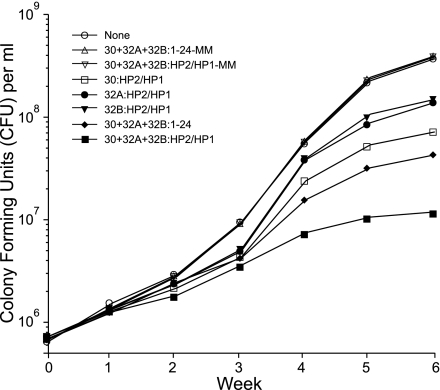Fig. 1.
Inhibition of M. tuberculosis growth by antisense HPS-ODNs specific for the 30/32-kDa protein gene complex. Duplicate bacterial cultures were grown for 6 weeks in 2 ml of 7H9 medium in the presence of antisense HPS-ODN(s) or mismatched HPS-ODNs (HPS-ODN-MM), which were added once at the start of the growth period at concentrations of 10 μM. For cultures with multiple HPS-ODNs, each of the matched or mismatched HPS-ODNs was added at a concentration of 10 μM. Cfus were enumerated weekly. The maximal standard deviation for each of the data points was 0.02 log cfu. The results shown are from a single experiment representative of three consecutive experiments with very similar results. In each of the three experiments, (i) differences in cfu between the group treated with three HPS-ODNs against the mycolyl transferases and each of the other groups, including the group treated with three unmodified PS-ODNs against the mycolyl transferases, were statistically significant (P < 0.0001 by ANOVA); (ii) differences in cfu between each of the groups treated with a single HPS-ODN against the 30-, 32A-, or 32B-kDa mycolyl transferase and groups treated with mismatched HPS-ODNs, mismatched unmodified PS-ODNs, or the untreated group were statistically significant (P < 0.0001 by ANOVA); and (iii) differences in cfu between the group treated with a single HPS-ODN against the 30-kDa protein and each of the groups treated with a single HPS-ODN against the 32A- or 32B-kDa protein were statistically significant (P < 0.0001 by ANOVA). HP1, hairpin 1; HP2, hairpin 2.

